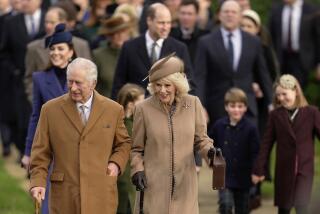A Royal Mess, but One Heck of a Story
- Share via
H.L. Mencken, the sardonic sage of American newspapers, called it “the greatest news story since the Resurrection,” and from the world’s reaction in December 1936, he was right:
A king of England was abdicating the most exalted of earthly thrones--for love. After a reign of only 11 months, Edward VIII, in a radio address written with the help of Winston Churchill, said he could not carry out his duties “as I would wish to do, without the help and support of the woman I love.”
“The woman he loved” was by royal standards a three-time loser: the king’s 40-year-old paramour, Wallis Warfield Simpson, twice divorced, a commoner and an American. At a time when divorced women could rarely be presented at court, she was not considered suitable to be queen or even wife to a king who was also head of the Church of England.
To the world, it was a bittersweet tale of love and sacrifice; in England it was a grave constitutional crisis. The specters of divorce and abdication have colored the conduct of the House of Windsor ever since.
Since before World War I, Edward Albert Christian George Andrew Patrick David, Prince of Wales, had been the world’s darling--charming, eternally boyish.
He was born to be king. Before his great-grandmother Queen Victoria came to the throne, the royal family was often scorned as buffoonish, licentious spendthrifts. Victoria and later Edward’s mother, Queen Mary, restored its luster with an oddly effective blend of regal dignity and middle-class values.
But Edward’s was a new generation. The world war had shattered the old order; a cultural revolution followed, a world whose idol was the winning and informal Prince of Wales. Every man wanted to be like him, every woman to marry or mother him.
He enjoyed rank’s advantages but chafed at its confining formalities, a rebellion which culminated in his abdication--as if he had always been looking for an escape hatch from the role he was born to.
One symptom was his affairs with married women, of whom Wallis Simpson appeared at first to be just one more. Sophisticated and ambitious, she was on her second marriage, to an Englishman who deferred when the future king came wooing his wife.
The besotted Edward ducked official duties to be with her. His devotion was slavish; one appalled servant quit when he saw Edward applying polish to his mistress’ toenails. When he became king in January 1936, he had already resolved to marry Simpson.
While American papers had a field day, the romance was largely kept out of British papers, which were protective toward the throne--unimaginable today. Not until just before the abdication did the affair hit England’s front pages.
Although popular opinion was split, neither British nor Commonwealth officials favored the marriage. The crisis showed every sign of becoming divisively political and damaging to the monarchy. Rather than prolong matters, Edward abdicated. His brother, the new king, George VI, made him Duke of Windsor.
He and Simpson married six months later, and led a glittering, restless life in exile. Although Simpson was vilified, her presence removed from the throne a man who was casual about its duties and perhaps dangerous in handling its few powers. Edward, who visited Hitler before the war, was notoriously pro-German.
Britons soon adjusted to a new king, but the royal family did not heal so fast. If a king had thought of his throne as a dispensable job, what might the nation think? To this day, hints that Queen Elizabeth II abdicate in favor of her heir are anathema.
Ironically, the marriage, which lasted until Edward died, was a model next to those of the queen’s children and sister. Princess Margaret was pressured to give up the divorced man she loved--and years later was divorced from the man she did wed. Of the queen’s four children, three divorced: Princess Anne; Prince Andrew, whose rollicking, red-haired wife Sarah Ferguson was sent packing after she was photographed in a topless romp with her financial advisor; and, most scandalous and almost as unimaginable as the queen’s own divorce, the heir to the throne, the Prince of Wales.
Both Charles and Diana, his glamorous but troubled wife, went shockingly public with marital confessions and complaints and with the salacious news that Diana had cuckolded Charles--for which she would have been beheaded centuries before--and that he had returned to the consolations of his old flame, Camilla Parker-Bowles.
Like the abdication, such modern embarrassments sparked speculation about the monarchy’s survival. The 19th century scholar Walter Bagehot wrote that royalty’s “mystery is its life. We must not let in daylight upon majesty.” Ever since Edward VIII flung the door open and walked out, the royals have agonized over how wide to open the door to that daylight.
More to Read
Sign up for Essential California
The most important California stories and recommendations in your inbox every morning.
You may occasionally receive promotional content from the Los Angeles Times.














